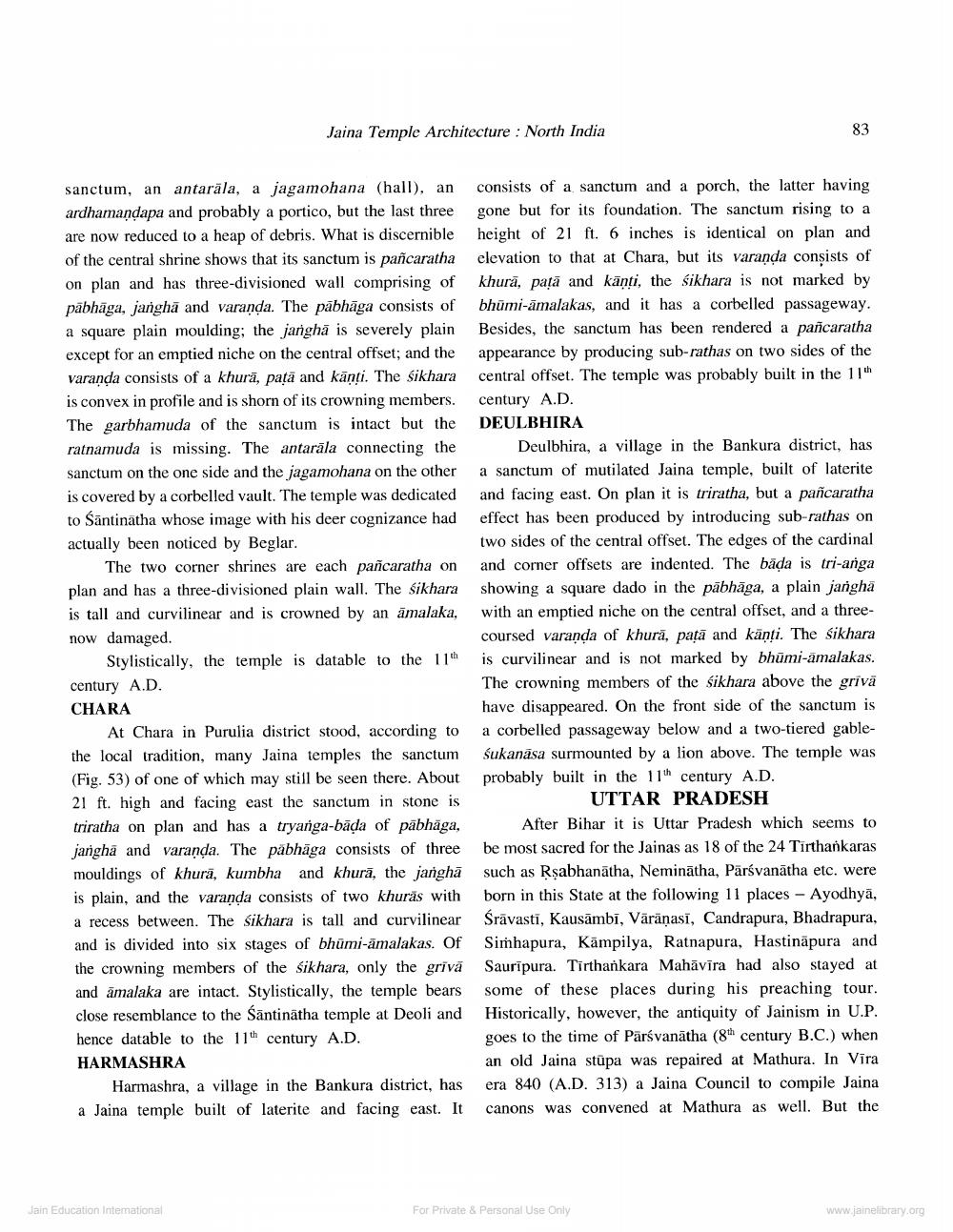________________
Jaina Temple Architecture : North India
sanctum, an antarala, a jagamohana (hall), an ardhamandapa and probably a portico, but the last three are now reduced to a heap of debris. What is discernible of the central shrine shows that its sanctum is pañcaratha on plan and has three-divisioned wall comprising of pābhāga, jangha and varanda. The pābhāga consists of a square plain moulding; the janghā is severely plain except for an emptied niche on the central offset; and the varanda consists of a khurā, patā and kāņti. The sikhara is convex in profile and is shorn of its crowning members. The garbhamuda of the sanctum is intact but the ratnamuda is missing. The antarāla connecting the sanctum on the one side and the jagamohana on the other is covered by a corbelled vault. The temple was dedicated to Sāntinātha whose image with his deer cognizance had actually been noticed by Beglar.
The two corner shrines are each pañcaratha on plan and has a three-divisioned plain wall. The sikhara is tall and curvilinear and is crowned by an amalaka, now damaged.
Stylistically, the temple is datable to the 11th century A.D. CHARA
At Chara in Purulia district stood, according to the local tradition, many Jaina temples the sanctum (Fig. 53) of one of which may still be seen there. About 21 ft. high and facing east the sanctum in stone is triratha on plan and has a tryanga-bada of pabhäga, janghā and varanda. The päbhāga consists of three mouldings of khurā, kumbha and khurā, the janghā is plain, and the varanda consists of two khuras with a recess between. The sikhara is tall and curvilinear and is divided into six stages of bhūmi-āmalakas. Of the crowning members of the Sikhara, only the grīvā and āmalaka are intact. Stylistically, the temple bears close resemblance to the Sāntinātha temple at Deoli and hence datable to the 11th century A.D. HARMASHRA
Harmashra, a village in the Bankura district, has a Jaina temple built of laterite and facing east. It
consists of a sanctum and a porch, the latter having gone but for its foundation. The sanctum rising to a height of 21 ft. 6 inches is identical on plan and elevation to that at Chara, but its varanda consists of khurā, pață and känti, the sikhara is not marked by bhūmi-āmalakas, and it has a corbelled passageway. Besides, the sanctum has been rendered a pañcaratha appearance by producing sub-rathas on two sides of the central offset. The temple was probably built in the 11th century A.D. DEULBHIRA
Deulbhira, a village in the Bankura district, has a sanctum of mutilated Jaina temple, built of laterite and facing east. On plan it is triratha, but a pañcaratha effect has been produced by introducing sub-rathas on two sides of the central offset. The edges of the cardinal and corner offsets are indented. The bada is tri-anga showing a square dado in the pābhāga, a plain jangha with an emptied niche on the central offset, and a threecoursed varanda of khură, pată and känti. The Sikhara is curvilinear and is not marked by bhūmi-amalakas. The crowning members of the sikhara above the grivä have disappeared. On the front side of the sanctum is a corbelled passageway below and a two-tiered gablesukanāsa surmounted by a lion above. The temple was probably built in the 11th century A.D.
UTTAR PRADESH After Bihar it is Uttar Pradesh which seems to be most sacred for the Jainas as 18 of the 24 Tirthankaras such as Rşabhanātha, Neminātha, Pärśvanātha etc. were born in this State at the following 11 places - Ayodhyā, Srāvasti, Kausämbi, Vārāṇasī, Candrapura, Bhadrapura, Simhapura, Kāmpilya, Ratnapura, Hastinapura and Saurīpura. Tirthankara Mahāvīra had also stayed at some of these places during his preaching tour. Historically, however, the antiquity of Jainism in U.P. goes to the time of Pārsvanātha (8th century B.C.) when an old Jaina stupa was repaired at Mathura. In Vīra era 840 (A.D. 313) a Jaina Council to compile Jaina canons was convened at Mathura as well. But the
Jain Education Intemational
For Private & Personal Use Only
For Private & Personal Use Only
www.jainelibrary.org




